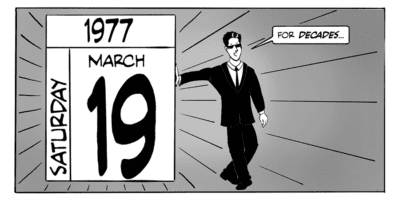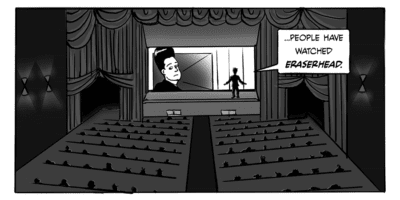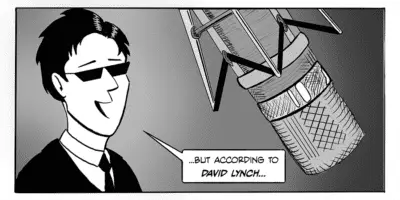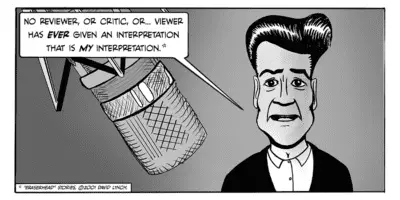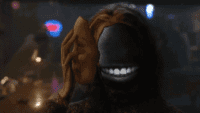Back in the late winter/early spring of this year, a Twitter account came to my attention. It promised to reveal the deep secrets behind David Lynch’s first film, Eraserhead, in a forthcoming graphic novel. On the 40th anniversary of the film’s release, The Key to Eraserhead was released, and I devoured it in one sitting that night after watching the film in honour of the occasion.
As part of 25 Years Later Site’s “Learn Lynch” series, we reached out to Jon Fairhurst, the brilliant mind behind The Key to Eraserhead, to pick his brain and find out more about both his wonderful graphic novel and the enigmatic film that inspired it.
25 Years Later: Tell us a little bit about what prompted you to write The Key to Eraserhead.
Jon: After decades of trying to figure out a “unified theory” about Eraserhead, I had an “aha” moment. But the answer wasn’t something simple, like “it’s about the chickens – or the bunnies”. The answer included a rich set of detailed connections, and from those connections, we can find meaning.
My discovery was that the quirky details in Eraserhead were inspired by lines from a famous work of classic literature. The text includes metaphoric imagery that Lynch translates from page to screen – but not at all as intended by the original author.
It took me some time to figure out how to communicate it. To just spill the beans 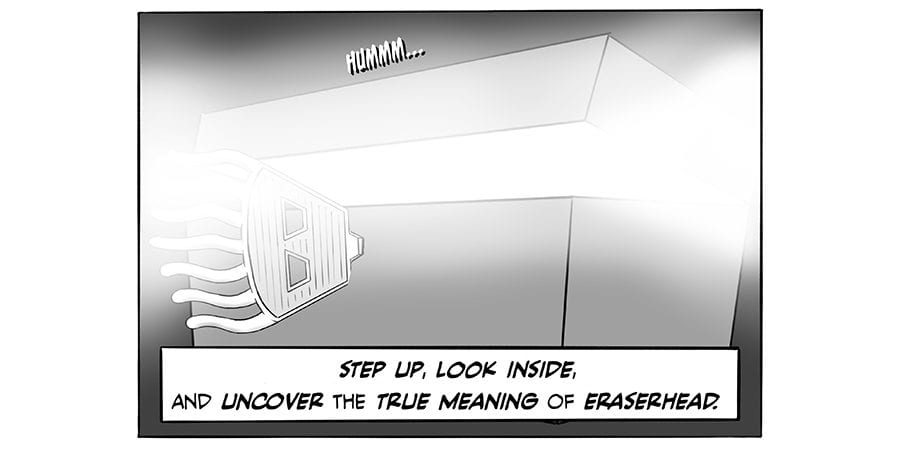 wouldn’t share all the juicy details. To write “The Key” in prose would lead to a thick, boring, analytical text. I considered juxtaposing the text on screenshots from the film, but many of the film’s images are dark and hard to read and the key point is often buried in the background. And then there was concern about copyright. That left the graphic novel approach where I could re-frame each scene and highlight the item or action in question.
wouldn’t share all the juicy details. To write “The Key” in prose would lead to a thick, boring, analytical text. I considered juxtaposing the text on screenshots from the film, but many of the film’s images are dark and hard to read and the key point is often buried in the background. And then there was concern about copyright. That left the graphic novel approach where I could re-frame each scene and highlight the item or action in question.
I think it’s effective. The images remind the reader of the concepts in the film in a right-brained way, the text overlays bring in the left-brain, and the reader gets to make their own connections between the two – as well as their own conclusions.
25YL: Without giving away the central premise of TKtE…what is it all about?
Jon: There are three parts in the book. The first is a teaser (that you can read on the website). The second shows the connections to the classic text. The third shows the connection to a book in the Bible (Lynch talks about the Bible in some of his Eraserhead interviews) and I tie it all together to find the overall meaning.
25YL: When did you first watch Eraserhead? And when did you first figure out the key to it all?
Jon: I first saw Eraserhead in the early 80s on a scrambled TV channel in Los Angeles. It really resonated with me, but left me groping for answers. I especially liked the inane humor.
I’ve read that the depressed brain makes too few connections, the paranoid-schizophrenic brain makes too many, and the normal brain makes just the right amount. The hyper-creative brain is just this side of schizophrenic, without losing touch with reality. Eraserhead lives right at the edge, so it was really enticing.
Over the years, I tried to figure it out, came up with many theories, and read theories on the Internet. But nothing explained the odd details, so I kept searching. Finally, a reviewer made a key observation about Henry’s character. That led me to the classic text. Looking at the Cliff’s Notes, you’d never find the connection. It was only when I read the detailed text that I found lines that related directly to scenes in the film. After that, the parallels in character and plot became more obvious. Lynch and company constructed quite the puzzle!
Looking back at my notes, that would have been in spring 2013. I then transcribed a detailed screenplay for the film and saved the text from the literary work and started cross-mining the two to find as many connections as I could.
25YL: How long did it take for you to write/illustrate TKtE? You released it on the 40th anniversary; was that always the goal all along?
Jon: Looking back, I started making an interactive website with screenshots and text overlays in mid-2013. This was really a proof-of-concept. The web scripting let me keep the formatting consistent and play with the ordering. The screenshots let me get a feel for the text-over-image thing and to see if it told a compelling story. After a lot of work, I dropped it as the screenshots were murky and didn’t highlight actions and ideas well and the web tools didn’t let me control the fonts as I would like. I thought of doing a graphic novel, but I hadn’t drawn comics since I was a kid and the work seemed daunting.
Fast forward to November 2015. Apple had launched the iPad Pro and the Apple Pencil. I bought the tablet in late December, but the Pencil was in hot demand, so I didn’t get my hands on one until February 2016 or so. I tried several graphics programs and found my clear choice in the Procreate app. (It’s great!) I used the Graphic app for text, fonts from Blambot, and Dropbox for storing, sharing, and organizing things. I used InDesign to put it all together in a publishable format. Oh, and I used a lot of paper for sketching things out and developing the story.
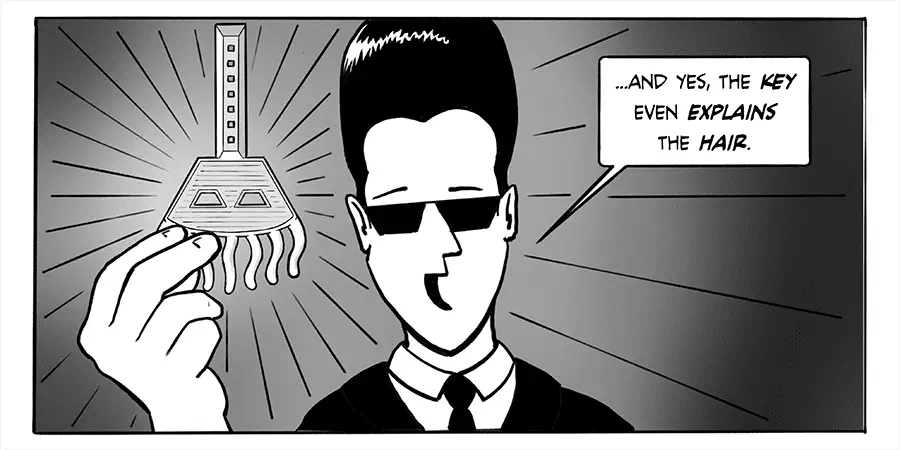 My first artwork was done as tracings and I spent a lot of time to come up with a style that I could perform consistently. I decided to do caricatures rather than tracings and to do simple, black-and-white gradients as fills. I used clean and simple lines, rather than a stylish, grungy look. I wanted it to be original, yet not to draw attention to itself. The idea is to trigger memories of the film, rather than to say, “look at my cool art!”
My first artwork was done as tracings and I spent a lot of time to come up with a style that I could perform consistently. I decided to do caricatures rather than tracings and to do simple, black-and-white gradients as fills. I used clean and simple lines, rather than a stylish, grungy look. I wanted it to be original, yet not to draw attention to itself. The idea is to trigger memories of the film, rather than to say, “look at my cool art!”
By April 2016, I had found the style and set the template. I was drawing panels in every spare moment. I started with super-rough sketches with text, so I could read and test the story. Late in the game, I totally re-wrote the final 3rd of the book as I was explaining too much and lacking focus. Throughout the process, I would go back to the original text, do more searches, and find yet more clues. Overall, I found well over 100 connections, but many were left on the cutting room floor.
In the fall of 2016, while watching Eraserhead Stories, I saw the poster for the first showing of Eraserhead, and I found the date – March 19th, 1977. That became my publishing target. I raced to finish the book, make the website, figure out how to publish an e-book, and get it done. As it turns out, my intro has just the right number of pages that I was able to reveal a panel a day from February 1st through March 19th. March 18th was tense, as I hoped that all the details were right. Fortunately, everything went as planned.
25YL: Eraserhead has variously been said to be, among other things, about a fear of fatherhood, fear of/fascination with sex, fear of fear itself (or emotions in general). In what ways does your interpretation in TKtE jibe with the existing, “established” interpretations? And in which ways is it totally separate?
Jon: All of the standard interpretations, fear of fatherhood, sex, fear itself, continue to 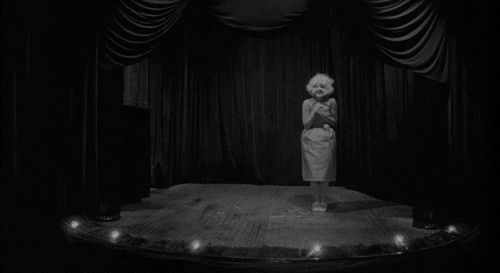 hold because they are so broad. One can also say that it’s about post-apocalyptic society, abortion, infanticide, dreams, middle-class social norms, etc. But none of these explain why Henry walks a crazy path over mounds of dirt or why an angelic lady lives in a radiator and has plaster on her cheeks.
hold because they are so broad. One can also say that it’s about post-apocalyptic society, abortion, infanticide, dreams, middle-class social norms, etc. But none of these explain why Henry walks a crazy path over mounds of dirt or why an angelic lady lives in a radiator and has plaster on her cheeks.
David Lynch took five years to make this film “just so.” He didn’t do all that meticulous work while lazily hacking out a screenplay full of random, meaningless events. It was clear to me on first viewing that everything in the film is highly intentional. That’s where “The Key” comes in. I’ve found a single source that presents detail after detail that relate to specific events in the film. As a sanity check, I read two other classic works by the same author. I wondered if his writing was so rich and creative that one can tie any of his works to Eraserhead. I found no resonance at all between Eraserhead and those other works.
Another thing missing in the standard interpretations is the spiritual angle. Lynch has often said that Eraserhead is his most spiritual film and that it relates to a line in the Bible. “Fear of fatherhood” is conceptual; it doesn’t make that specific connection.
“The Key” ties Eraserhead to Revelation. (Is this a surprise, given the post-apocalyptic setting?) Now imagine that you want to make an allegorical film about Revelation. That book is a prophesy with a string of specific images. But if you put those images on screen, for instance a beast with seven heads and ten horns, the film would no longer be allegorical; it would be Revelation. So the trick is that Lynch found his prophetic images not in the Bible but from a different, classical text. So, as Henry sees these odd things happen, he knows that something is up, but he doesn’t know what it means. By the time he sees the images in his dreams, he knows it’s serious!
25YL: What’s your favourite/least favourite scene in Eraserhead and why?
I love every scene, but one that really hits me is when The Beautiful Girl Across the Hall says, “Where’s your wife?” Henry looks around, disoriented and then says, “She must have gone back to her parents again… I’m not sure.”
That scene speaks to the dream experience. In a dream, when reality changes or doesn’t make sense, we explain it away. We never say, “this doesn’t make sense. I must be dreaming”, yet we can’t quite put our finger on what is wrong. (Not to mention that there are subtle clues from earlier scenes that Mary has committed suicide and is dead. This makes the scene even more powerful. Unfortunately, I found these clues after publication, so it’s not in the book.)
I used to find the pencil factory scene to be my least favorite. The outdoor shots have an ugly density with low, dark contrast and it seemed like an elaborate setup to tell the pun in the film’s title. Now I see it quite differently. The strange tone is associated with Henry’s visions, the prophetic images continue to be presented, and it’s a seminal moment for Henry’s character. If you map the film to the hero’s journey, this is the moment that Henry passes the test. When the technician blandly says, “it’s okay”, he might as well have said, “Henry is the one. He is the Eraserhead.” But this isn’t a superhero film. Or Dune.
25YL: Many people have talked about how The Return seems to function on some level as a “magnum opus” chronicling or summarizing in some way the entirety of
Lynch’s career. There were some clear callbacks to Eraserhead (Major Briggs’s
floating head in Part 3, most obviously); were there any callbacks to Eraserhead
that stood out to you? Or any thematic links that made you jump out of your
seat?
Jon: There were some huge echoes from Eraserhead, including numerous sound effects. For instance, in Part 17, as a floating object starts to move, Lynch plays the sound of Eraserhead’s radiator doors opening. The radiator is like heaven and this is a bit like the gods giving Cooper a hand to defeat Mr. C.
Dougie’s elevator scenes were reminiscent of Henry standing so long in his apartment lobby. The lobby and elevator are transitional spaces between the inside and outside worlds – or in the case of The Return, between home and work. Lynch loves the space between here and there, as we see in the long drive from Texas to Washington in Part 18.
Then there is the dead tree (The Tree of Life?) next to Henry’s bed which is reflected in The Evolution of the Arm.
The big one was, of course, the mushroom cloud. In Eraserhead, it’s just a small photograph on the wall of the apartment. When Lynch gives interviews, listen for the words he whispers or blows by quickly. It’s a “tell” that that thing is important. Lynch never points the lens directly at that small photo and, yes, it’s very important. Forty years later, just in case we didn’t get it, he SHOUTS it in The Return. Just in case the giant photo in Gordon Cole’s office doesn’t hit us over the head hard enough, Lynch delivers an atomic crescendo in the masterpiece that is Part 8.
As we often see, Lynch loves to play with time. If his most recent work, The Return,
shows the beginning of the end, his first feature film, Eraserhead, depicts his unique
vision of its culmination.
25YL: We’re right at the start of a brand new series here on the site where we introduce one Lynch film a week to people who haven’t seen it before. In that vein, what advice would you give to someone watching Eraserhead for the first time?
Jon: First, this film isn’t for everybody. It’s slow. It has “biological props”. And if you have a newborn baby, give it a few years until you click, “play”. On the other hand, if you like dark, challenging films, put this at the top of your list.
On first viewing, just drink it in. You won’t solve the puzzle without noodling about it or without reading outside texts, so don’t bother trying. Also, don’t watch this when you risk interruptions – or during the day. This is a film for late at night when you close the curtains, turn out the lights, have gone to the bathroom, and already have your food and drink at hand. Be patient and get into the rhythm and mood of the film. Puzzle on what it all means later. And then read The Key.
25YL: Where can people find your graphic novel? Are you working on anything else now? (Maybe “The Key to Inland Empire”??? I’d pay goooood money for a Cliffs Notes version of that film!!!)
Jon: No, I don’t have any other projects in the works. It was a real gold strike to find the specific texts that inspired Eraserhead. I don’t know that I could ever find another Key. But you never know, sometimes lightning strikes twice.
You can get the book on iTunes and Amazon Kindle. I hope the people enjoy it. And I hope that The Key opens up new, deeper understandings than I was able to uncover. Not everybody agrees on the interpretations of Revelations or of the classical text, so uncovering overall meanings from these works will likely never end.
Jon has made The Key to Eraserhead available at the special price of $4.99 starting today, so take advantage of it and grab a copy!

